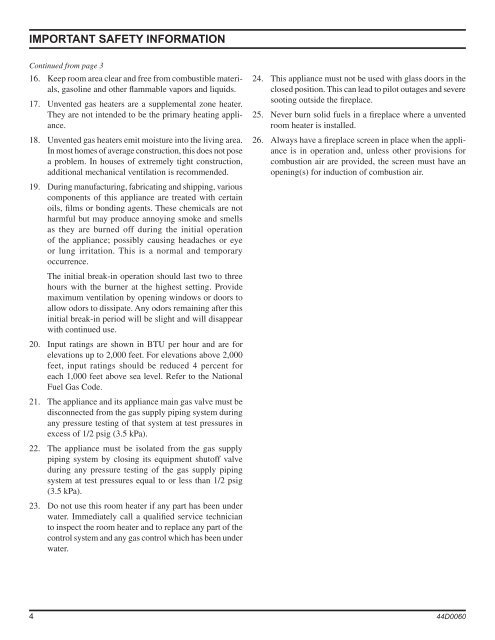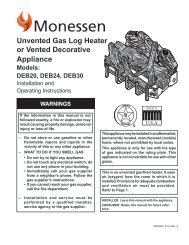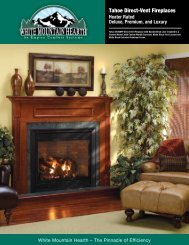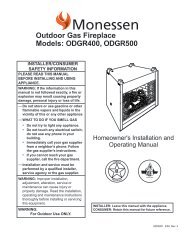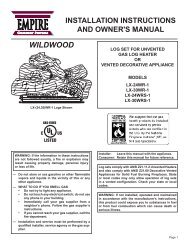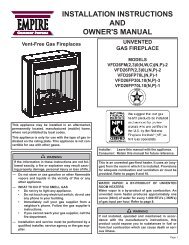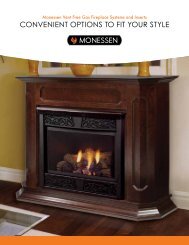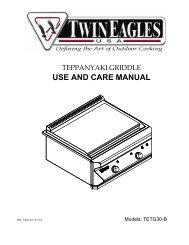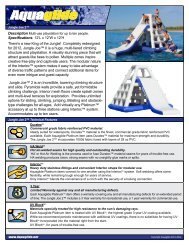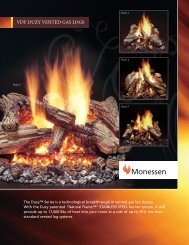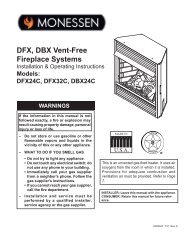unvented gas log heater or vented decorative ... - Spotlight Retail
unvented gas log heater or vented decorative ... - Spotlight Retail
unvented gas log heater or vented decorative ... - Spotlight Retail
Create successful ePaper yourself
Turn your PDF publications into a flip-book with our unique Google optimized e-Paper software.
IMPORTANT SAFETY INFORMATION<br />
Continued from page 3<br />
16. Keep room area clear and free from combustible materials,<br />
<strong>gas</strong>oline and other flammable vap<strong>or</strong>s and liquids.<br />
17. Un<strong>vented</strong> <strong>gas</strong> <strong>heater</strong>s are a supplemental zone <strong>heater</strong>.<br />
They are not intended to be the primary heating appliance.<br />
18. Un<strong>vented</strong> <strong>gas</strong> <strong>heater</strong>s emit moisture into the living area.<br />
In most homes of average construction, this does not pose<br />
a problem. In houses of extremely tight construction,<br />
additional mechanical ventilation is recommended.<br />
19. During manufacturing, fabricating and shipping, various<br />
components of this appliance are treated with certain<br />
oils, films <strong>or</strong> bonding agents. These chemicals are not<br />
harmful but may produce annoying smoke and smells<br />
as they are burned off during the initial operation<br />
of the appliance; possibly causing headaches <strong>or</strong> eye<br />
<strong>or</strong> lung irritation. This is a n<strong>or</strong>mal and temp<strong>or</strong>ary<br />
occurrence.<br />
The initial break-in operation should last two to three<br />
hours with the burner at the highest setting. Provide<br />
maximum ventilation by opening windows <strong>or</strong> do<strong>or</strong>s to<br />
allow od<strong>or</strong>s to dissipate. Any od<strong>or</strong>s remaining after this<br />
initial break-in period will be slight and will disappear<br />
with continued use.<br />
20. Input ratings are shown in BTU per hour and are f<strong>or</strong><br />
elevations up to 2,000 feet. F<strong>or</strong> elevations above 2,000<br />
feet, input ratings should be reduced 4 percent f<strong>or</strong><br />
each 1,000 feet above sea level. Refer to the National<br />
Fuel Gas Code.<br />
21. The appliance and its appliance main <strong>gas</strong> valve must be<br />
disconnected from the <strong>gas</strong> supply piping system during<br />
any pressure testing of that system at test pressures in<br />
excess of 1/2 psig (3.5 kPa).<br />
22. The appliance must be isolated from the <strong>gas</strong> supply<br />
piping system by closing its equipment shutoff valve<br />
during any pressure testing of the <strong>gas</strong> supply piping<br />
system at test pressures equal to <strong>or</strong> less than 1/2 psig<br />
(3.5 kPa).<br />
23. Do not use this room <strong>heater</strong> if any part has been under<br />
water. Immediately call a qualified service technician<br />
to inspect the room <strong>heater</strong> and to replace any part of the<br />
control system and any <strong>gas</strong> control which has been under<br />
water.<br />
24. This appliance must not be used with glass do<strong>or</strong>s in the<br />
closed position. This can lead to pilot outages and severe<br />
sooting outside the fireplace.<br />
25. Never burn solid fuels in a fireplace where a <strong>un<strong>vented</strong></strong><br />
room <strong>heater</strong> is installed.<br />
26. Always have a fireplace screen in place when the appliance<br />
is in operation and, unless other provisions f<strong>or</strong><br />
combustion air are provided, the screen must have an<br />
opening(s) f<strong>or</strong> induction of combustion air.<br />
4 44D0060


